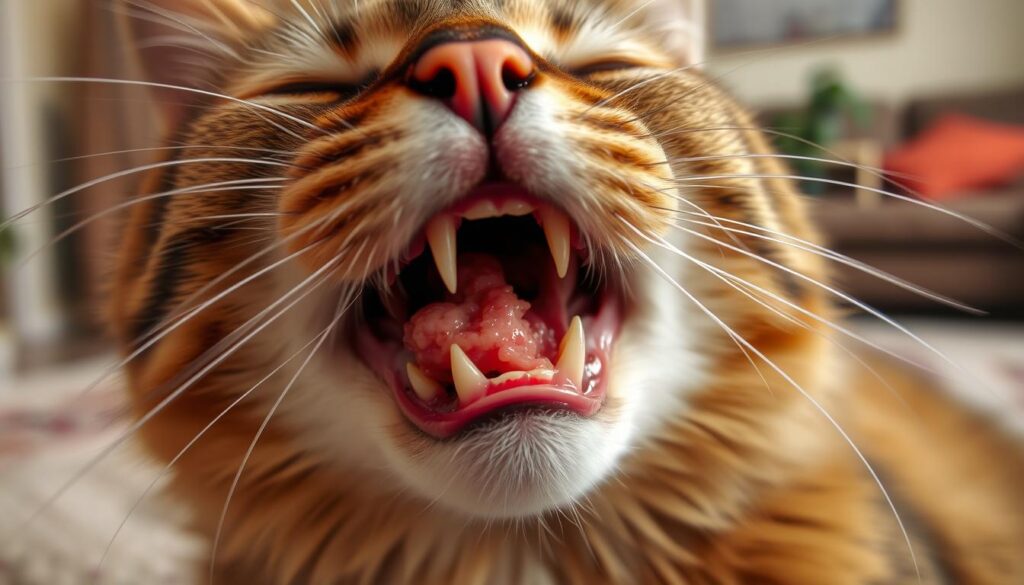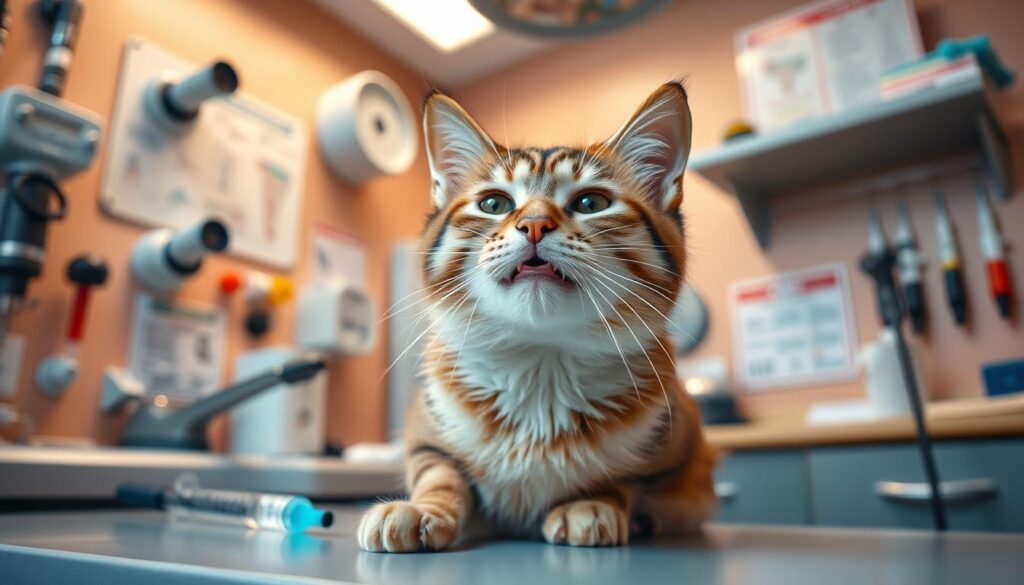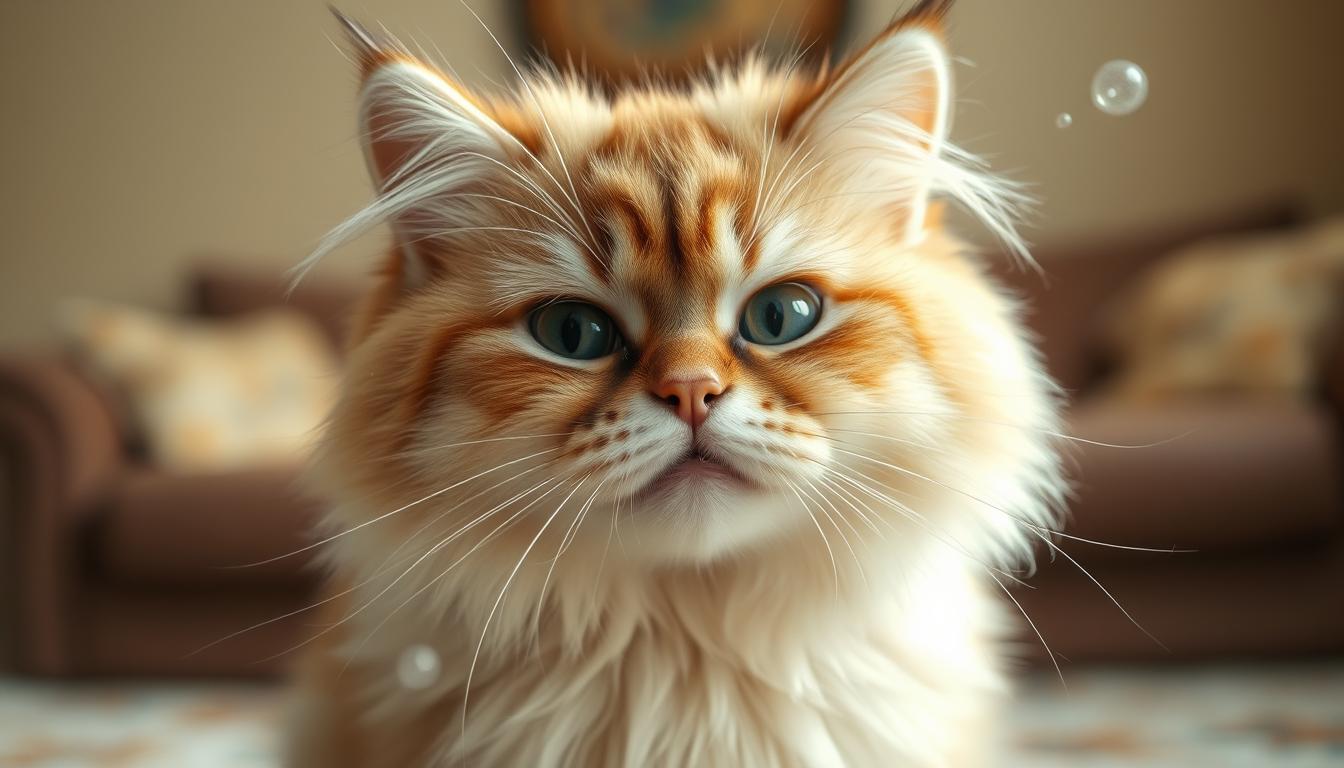If your cat is sneezing a lot, you might be worried. Sneezing now and then is usually okay. But if it happens a lot, it could mean there’s something wrong that needs to be checked.
Sneezing helps cats get rid of stuff in their noses. But if your cat’s sneezing changes or they have other symptoms, you should take them to the vet.
There are many reasons why cats sneeze. It could be because of dust, pollen, or even something more serious like a respiratory infection. Knowing why your cat is sneezing can help you figure out how to help them.
Table of Contents
Understanding Normal vs. Problematic Cat Sneezing
Sneezing is common in cats and usually harmless. But, if your cat sneezes a lot, it might mean they have a health issue. Knowing when sneezing is normal and when it’s not is key.
What Constitutes Normal Sneezing Patterns
Cats sneeze sometimes because of things like dust or strong smells. This kind of sneezing doesn’t bother them much. They might also sneeze when they’re excited or moving around, as a way to clear their nose.
Signs of Concerning Sneezing Behavior
- Frequent or persistent sneezing, especially if it’s with other symptoms like nasal discharge, trouble breathing, or not wanting to eat.
- Sneezing that messes up your cat’s daily life and makes them uncomfortable.
- Sneezing that happens because of stress or things like viral infections, like feline herpesvirus.
Impact on Your Cat’s Daily Life
Too much sneezing can really affect a cat’s life. Cats with a lot of sneezing might have trouble breathing, feel uncomfortable, and not want to eat. This can make them less active, withdraw from social interactions, and feel really unwell.
If your cat’s sneezing is worrying or keeps them from doing things, see a vet. They can find out why and help fix it. Knowing when sneezing is normal helps you take care of your cat’s health and happiness.
Common Environmental Triggers for Cat Sneezing
If your cat sneezes a lot, it might be because of their surroundings. Cats can react to cat allergens and household irritants in their environment. These can make them sneeze.
Dust is a common culprit. Dust mites and dust from litter boxes or bedding can irritate a cat’s nose. This leads to sneezing. Also, pollen from plants can cause sneezing in cats with allergies.
Strong odors can also make cats sneeze. This includes smells from cleaning products, perfumes, or cigarette smoke. Dry air and low humidity can dry out a cat’s nose, causing irritation and sneezing.
Cats might sneeze if they have something stuck in their nose, like grass or small toys. Taking out these irritants can help stop the sneezing.
To reduce sneezing, use air purifiers, humidifiers, and hypoallergenic litter. Clean your cat’s area often and avoid strong smells. This can help a lot.
If your cat keeps sneezing or shows other signs of illness, see a vet. They can find out why and help your cat feel better.
My Cat Keeps Sneezing: Medical Causes and Conditions
If your cat sneezes a lot, it might mean they have a health problem. Viral and bacterial infections, and chronic conditions often cause sneezing in cats. Knowing the causes can help you care for your pet better.
Viral Respiratory Infections
Feline herpesvirus and calicivirus are common causes of sneezing in cats. These viruses lead to symptoms like nasal congestion and sneezing. Quick vet care and the right medicine can help manage these infections.
Bacterial Infections and Secondary Complications
Bacterial infections, like bacterial rhinitis, can also make cats sneeze. Conditions like Bordetella and Mycoplasma can worsen respiratory problems. Sometimes, these infections come after a viral infection or another health issue.
Chronic Medical Conditions
Chronic rhinitis is an ongoing inflammation in the nasal passages. It can be caused by allergies, structural issues, or even cancer. Finding the cause and managing it long-term is key for cats with chronic rhinitis.
Working with your vet is crucial to find out why your cat sneezes and treat it. Regular vet visits and quick action on symptoms are important for your cat’s health.
The Connection Between Dental Problems and Sneezing
Sneezing is common in cats, but there’s often a hidden reason. Dental disease can lead to sneezing. When teeth are infected or gums are inflamed, they can reach the nasal passages. This lets food get into the nose, causing sneezing.
Signs your cat’s sneezing might be linked to dental issues include:
- Sneezing, especially after eating
- Noticeable bad breath
- Reluctance to eat or chew
Your vet can check for dental problems that cause sneezing. Fixing dental disease, like pulling teeth or deep cleaning, can stop the sneezing.
| Dental Issue | Impact on Nasal Health |
|---|---|
| Feline Dental Disease | Infected teeth or severe gum inflammation can penetrate the barrier between tooth sockets and nasal passages, allowing food material to enter the nose and trigger sneezing. |
| Tooth Root Infections | Infections along the upper arcade of a cat’s teeth can result in sneezing as the roots may be close to nasal passageways. |
Keep your cat’s teeth clean with vet visits and dental cleanings. Dental-friendly treats and toys also help. They keep your cat’s mouth healthy and prevent sneezing caused by dental problems.

“More than half of all cats over the age of three have some form of dental disease, making it one of the most common medical conditions seen by veterinarians.”
How to Identify Different Types of Nasal Discharge
When your cat sneezes, the nasal discharge can tell you a lot. Knowing the difference between clear, colored, and bloody discharge is key. It helps you know when to get vet help.
Clear vs. Colored Discharge
Clear, watery discharge often means your cat has a viral infection or allergies. It’s usually due to inflammation in the nose. Yellow or green discharge, however, points to a bacterial infection that might need antibiotics.
Blood-Tinged Discharge Concerns
Seeing blood in your cat’s nasal discharge is a big worry. It could mean serious issues like tumors, severe inflammation, or nose trauma. Getting your cat to the vet fast is crucial.
When Discharge Indicates Emergency
If your cat’s nasal discharge doesn’t stop or is a lot, it’s an emergency. Add symptoms like trouble breathing or a lot of bleeding, and it’s even more urgent. Your cat needs quick vet care to stay safe.
| Discharge Type | Potential Causes | Veterinary Attention Needed |
|---|---|---|
| Clear, watery | Viral infections, allergies | May not require immediate vet visit, but monitor for worsening symptoms |
| Yellow or green | Bacterial infections | Vet visit recommended for proper diagnosis and treatment |
| Blood-tinged | Tumors, severe inflammation, trauma | Immediate vet visit required |
| Persistent or excessive | Variety of underlying causes | Immediate vet visit required, especially if accompanied by other symptoms |
Watching your cat’s nasal discharge closely can help you understand what’s going on. It tells you when to get vet help. Being quick to act can keep your cat healthy and happy.
Diagnostic Procedures Your Vet May Recommend
If your cat keeps sneezing, your vet might suggest some tests. These veterinary diagnostics aim to find out why your cat is sneezing. They could be looking for infections, allergies, or other issues.
The first thing your vet will do is a physical examination. They will check your cat’s nose and overall health. Then, they might do more tests, like:
- Blood work to check for signs of infection or underlying medical conditions
- Nasal swabs to collect samples for feline nasal examination and identify any bacterial or viral agents
- Imaging studies, like X-rays or CT scans, to visualize the nasal and sinus structures
- Rhinoscopy, a procedure where a tiny camera is inserted into the nasal passages under anesthesia to inspect for polyps or foreign objects
- Nasal lavage, which involves flushing the nasal passages to collect samples for analysis
- Nasal biopsies to rule out the presence of tumors or chronic conditions
These cat sneezing tests help find out why your cat is sneezing. It could be a virus, a dental issue, or something else. Once they know, they can start treating your cat to make them feel better.
| Diagnostic Procedure | Purpose |
|---|---|
| Physical Examination | Evaluate overall health and nasal passages |
| Blood Work | Check for signs of infection or underlying conditions |
| Nasal Swabs | Identify bacterial or viral agents causing sneezing |
| Imaging (X-rays, CT Scans) | Visualize nasal and sinus structures |
| Rhinoscopy | Inspect nasal passages for polyps or foreign objects |
| Nasal Lavage | Collect samples for analysis |
| Nasal Biopsies | Rule out tumors or chronic conditions |
By working with your vet and doing the right veterinary diagnostics, you can help your cat feel better. This ensures their sneezing is taken care of and they stay healthy.

Treatment Options for Sneezing Cats
If your cat is sneezing a lot, you need to find out why. The treatment depends on the cause. Your vet will suggest ways to help your cat feel better.
Medical Interventions
For infections like feline herpesvirus, your vet might give antibiotics or antivirals. If it’s a bacterial or fungal infection, they’ll use specific treatments. Cats with ongoing health issues might need long-term care, like steroids or special diets.
Home Care Recommendations
Your vet might also recommend home care. This includes using a humidifier and cleaning your cat’s space often. Keeping your cat hydrated and ensuring good dental care are also important.
Preventive Measures
To prevent sneezing, your vet might suggest regular vaccinations. Keeping your cat’s teeth clean and avoiding irritants like cigarette smoke are also good ideas.
By following your vet’s advice, you can help your cat feel better. Early action and care are crucial for your cat’s health.
Creating a Sneeze-Free Environment for Your Cat
To keep your cat healthy and comfy, start by making your home sneeze-free. Clean regularly, cut down on allergens, and keep the air clean. These steps can help lessen what makes your cat sneeze.
Clean your cat’s spots, like their bed and litter box, well. Vacuum often to get rid of dust and pollen. A HEPA air purifier can also help clean the air in your home.
- Regularly clean your cat’s bedding and litter box to reduce exposure to allergens.
- Use a HEPA air purifier to filter out airborne irritants like dust and pollen.
- Avoid strong-smelling chemicals, perfumes, and household cleaners that can irritate your cat’s sensitive nose.
It’s also key to keep the humidity right in your home. Dry air can make your cat’s nose itch more, leading to sneezing. Use a humidifier to keep the air moist, between 30-50% humidity.
Good air flow is another must. Open windows to let in fresh air and reduce irritants. Also, think about getting a new HVAC system with HEPA filters for better air inside.
| Allergy Triggers | Solutions |
|---|---|
| Dust mites | Regularly vacuum, use HEPA air purifier |
| Pollen | Keep windows closed, use HEPA air purifier |
| Mold | Maintain proper humidity, address any moisture issues |
By making your home cat-friendly, you can cut down on allergens and keep the air clean. This helps your cat breathe better and sneeze less often.
When to Seek Emergency Veterinary Care
Cat respiratory emergencies need quick action, as they can turn deadly fast. If your cat has trouble breathing, like rapid breathing or wheezing, get vet care fast. Also, if they keep sneezing and show signs of illness, like fever or acting differently, see a vet right away.
Big nosebleeds are a big worry and mean you need to see a vet fast. If your cat is very tired or just sneezes a lot, it’s serious. These signs might mean they have a big problem that needs quick help.
- Rapid or labored breathing
- Wheezing or coughing
- Persistent sneezing with loss of appetite, fever, or behavior changes
- Significant nasal bleeding
- Severe lethargy or extreme fatigue
When it comes to cat respiratory emergencies, it’s always better to err on the side of caution. If you’re not sure how bad your cat’s condition is, call your vet. Quick and right care can really help your cat get better and stay healthy.
Early spotting and action are key in dealing with cat respiratory emergencies. By watching closely and getting vet care when needed, you can help your cat get through tough times. This way, they can stay healthy and happy.
Conclusion
While cats sometimes sneeze, it’s important to watch for signs of trouble. Knowing what causes sneezing in cats is crucial. This includes things like allergies, viruses, and dental issues.
Regular vet visits and a clean home are key to keeping your cat healthy. If your cat’s sneezing gets worse, don’t wait to see a vet. They can find out why your cat is sneezing and help fix the problem.
Being careful about your cat’s sneezing and working with your vet can make a big difference. A clean home and quick vet visits can help your cat feel better. Remember, taking care of your cat’s health is important for their happiness and well-being.


1 thought on “Why My Cat Keeps Sneezing – Signs & Solutions”